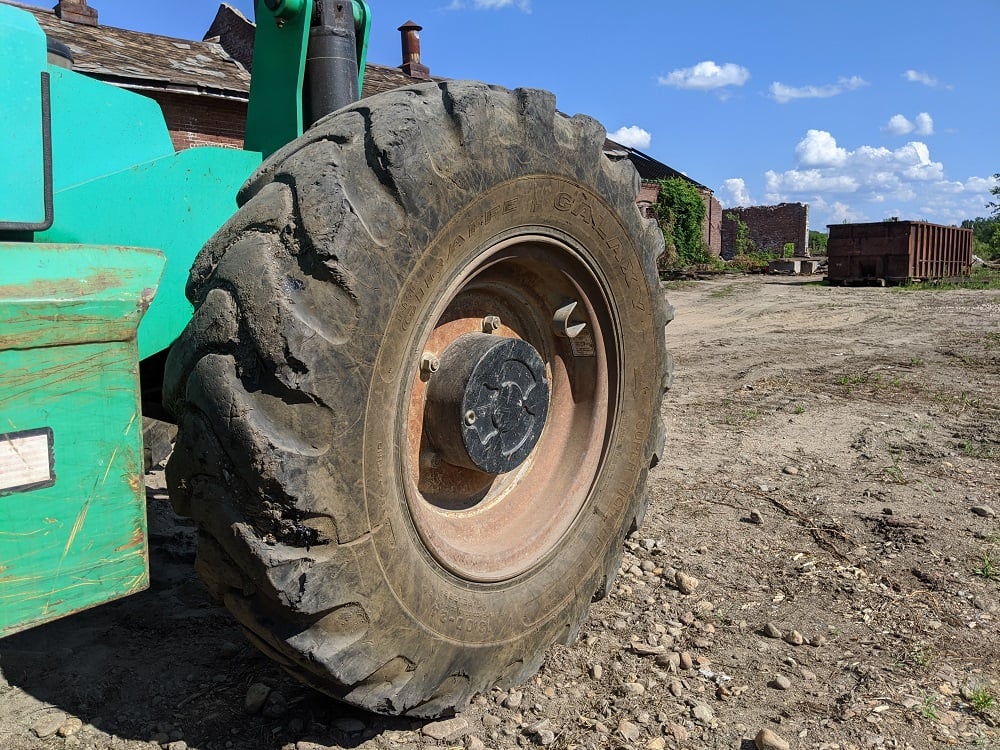Tire Damage Detective Work
Tires keep valuable construction machinery moving, contribute significantly to their productivity, and represent one of the most costly consumables in relation to both compact and heavy equipment alike. One way you can make the most of this investment is to routinely check your equipment’s tires, understand what signs of wear or damage are saying about their use, and use that knowledge to extend tire life (maximizing performance and minimizing cost) or find the best replacement tire possible (forestalling future problems).

Underinflation and Overinflation Issues
In a pneumatic tire both underinflation and overinflation cause unnecessary stress—making them two of the most common causes of short tire life and underperformance. Regularly checking the tire pressure of your equipment is one of the easiest ways to help tires last longer, improve machine efficiency, and achieve a better bottom line.
If you have not been in the habit of routinely checking your tire pressure, here are some tell-tale signs that you’ve been running your equipment on underinflated or overinflated tires.
Underinflated Tires
The common signs of underinflated tires are:
- Excessive wear on the outside tread edge—this is especially true of bias-ply tires, whose contact patch will bow inward when underinflated.
- Diagonal cracking on the upper sidewall resulting from excessive tire deflection when torque is applied to the tire.
- Cracks running perpendicular from the shoulder of the tire to the bead—this is most common in bar-lug tractor-type tires that get a lot of hard surface use and is the result of heat buildup and the wiggling of deep-bar lugs on the road.
- Sidewall separation from impacts or pinching.
Another startling and potentially dangerous sign of underinflation is “zipper rupture,” which is a spontaneous burst of compressed air that occurs in the sidewall/flex area of a tire. One of the scariest things about zipper rupture is that there are rarely any surface signs of tire damage; consequently, ruptures occur without any warning. Any tire operated at less than 80% of proper inflation can possibly have structural damage, is at risk for zipper rupture, and should be pulled from service.
Overinflated Tires
The common signs of overinflated tires are:
- Excessive wear in the center of the tread—this is particularly true of bias-ply tires, which will crown when overinflated.
- Impact breaks, which is damage to a tire carcass caused by banging, bumping, and colliding with obstacles.
Load and Speed
The speed/load index found on a tire’s sidewall is a statement of the speed a tire can travel at and the load it can carry at maximum air pressure. Exceeding these limits is another way to overstress and shorten the life of your tires—for example, excessive heat generated by an overloaded tire or tire driven above the recommended speed can melt the rubber belt or ply coatings inside of a tire, creating the risk of tire failure.
Overloading: Increases friction and heat buildup, which leads to premature tire wear. Signs of an overloaded tire include separation of the chafer strip, cracks in the bead area, and sidewall cracks or bubbles. Also, the excessive flex and heat buildup caused by overloading can have the same effect as underinflation and result in zipper rupture.
Speeding: Operating at too fast speeds is also problematic, as it can lead to shoulder belt and lug separation, and uneven shoulder wear.
Tire Storage
How tires are stored can also affect their longevity. UV or sunlight can cause superficial cracking or crazing on tires, as can ozone from electric motors and welders. Similarly, exposure to corrosive materials can manifest themselves as blisters or discoloration.
Operator Behavior
Operators are the primary cause of premature tire wear and the steps taken to ensure that equipment is operated at the proper air pressure, within their speed and load limits, and stored correctly are easily undone by aggressive driving. The most obvious signs of inattentive operation or driving too fast is damage like sidewall cuts and tears caused by running into avoidable obstacles.
Other signs that operators are pushing a machine’s tires past their limit include shoulder separation and lug tear, uneven shoulder wear, and sidewall bubbles, which can all be caused by high-speed cornering.
Application-Specific Tires
An understanding of the wear of your equipment’s tires is a valuable piece of knowledge when it comes time to replace them. Choosing an application-specific tire—a tire designed for the terrain, obstacles, and challenges facing your particular application—is one of the best ways to ensure maximum tire life and return on your tire investment.
For example, a skid steer working on hard surfaces will benefit from a tire like our Galaxy Hulk, which is engineered for increased abrasion resistance to stand up to surfaces like asphalt and concrete. Conversely, a skid steer working on soft surfaces is better off with a tire like our Galaxy Beefy Baby III, which is built with greater cut and chip resistance for standing up to rock and gravel construction sites.
Some questions you should ask when selecting an application-specific tire include:
- Is the tire wear I’m seeing solvable by changing tires?
- What types of terrain are my tires working in?
- What is the severity of the job?
- How fast is my equipment traveling?
- How much traction is required?
To learn more about how to read the signs of tire damage, listen to our senior tire development engineer, Tian Blomerus, on Rental’s The Bottom Line Podcast.
The Alliance/Galaxy Advantage
We are committed to solving the real-world issues facing operators in the field. Because of this, we offer a tire solution for whatever tire-related problem is affecting your equipment, from high-tech radials to super-durable solids. Contact your local dealer or rep today to find a problem-solving offering from our wide range of tires.

